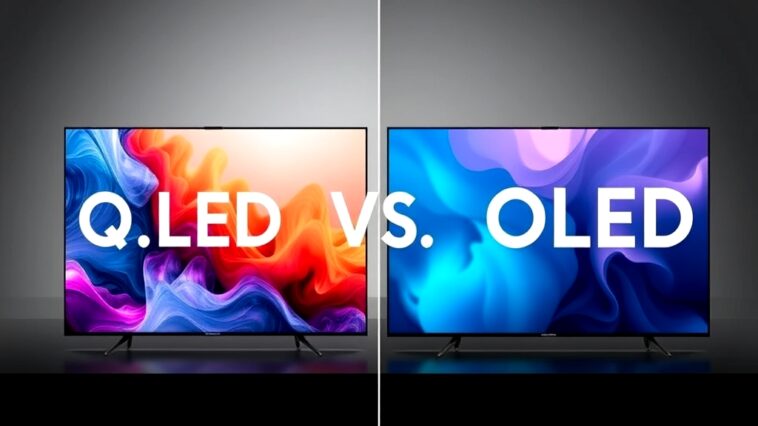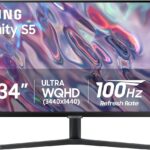Introduction
In the ever-evolving world of television technology, two major players stand out: QLED and OLED. These acronyms might seem confusing, but they represent two distinct types of display technology, each with its own strengths and weaknesses. This article aims to provide a comprehensive overview of both QLED and OLED technologies, help you understand their differences, and guide you in making an informed decision on which might be best for your needs. Written by experts in display technology and thoroughly fact-checked, this guide is designed to simplify complex ideas into easy-to-understand language.
1. What Is QLED?
1.1 Definition and Technology
QLED stands for Quantum Dot Light Emitting Diode. It is a type of display technology that relies on an LCD (liquid crystal display) panel but enhances the picture quality with the use of quantum dots. So, what are quantum dots? Imagine tiny particles that can emit specific colors when illuminated by light. When a QLED TV uses a backlight to shine through these quantum dots, they produce brighter and more vibrant colors. This makes the images on the screen look more realistic compared to standard LCDs.
1.2 Key Features of QLED
One of the standout features of QLED technology is its ability to achieve higher peak brightness levels. This means that in very bright rooms, QLED TVs can still display clear and vivid images without losing detail. Another advantage is the enhanced color gamut, which allows QLED TVs to display a wider range of colors compared to other panel types like IPS (In-Plane Switching), TN (Twisted Nematic), and VA (Vertical Alignment) panels.
When comparing these technologies, it’s important to note that QLED tends to excel in brightness and color range, making it suitable for varied lighting conditions.
1.3 Examples of QLED Usage
Samsung is one of the leading manufacturers of QLED TVs, with its Neo QLED models showcasing the latest advancements in this technology. These TVs offer impressive picture quality and brightness levels, making them a popular choice among consumers. Additionally, LG has developed its own technology called Nano IPS, which, while not QLED, shares similarities in terms of color accuracy and brightness, further diversifying the options available for consumers.
2. What Is OLED?
2.1 Definition and Technology
OLED stands for Organic Light Emitting Diode. This technology is quite different from QLED because OLED panels are self-emitting. This means that each pixel in an OLED screen can turn on and off independently. When a pixel is turned off, it produces a true black, leading to an infinite contrast ratio. This quality makes OLED displays famous for their stunning color reproduction and deep blacks, which results in an overall richer picture.
2.2 Key Features of OLED
One of the most impressive features of OLED technology is its instantaneous response time. This means that when scenes change quickly, like in action films or video games, the images transition without any blurring. Additionally, OLED screens offer wider viewing angles than QLED. This is beneficial when watching TV with a group of friends or family since everyone can enjoy a clear image, no matter where they sit in relation to the screen.
However, OLED technology has some drawbacks, such as generally lower peak brightness levels compared to QLED and the risk of burn-in or image retention. Burn-in occurs when static images remain on the screen for too long, causing a ghostly image to linger.
2.3 Modern Improvements
Manufacturers have recognized the burn-in issue and have introduced features in modern OLED displays to help mitigate this risk. Techniques like pixel shifting and screen savers can help ensure that static images do not cause permanent damage to the display, making OLED TVs more reliable for everyday use.
3. QLED vs OLED: Side-by-Side Comparison
3.1 Brightness
When comparing brightness levels, QLED generally outperforms OLED. QLED TVs can achieve higher peak brightness, which is particularly useful in well-lit rooms. This advantage allows viewers to enjoy vibrant colors and details even in direct sunlight. Conversely, OLED displays may struggle in bright conditions but excel in darker environments where their ability to produce true blacks shines.
3.2 Contrast Ratio
Contrast ratio measures the difference between the darkest and brightest parts of an image. OLED’s self-emitting pixels can turn off completely, providing perfect blacks and an infinite contrast ratio. This feature greatly enhances the overall image quality, making it ideal for watching movies in dimly lit rooms. In contrast, QLED TVs, while bright, cannot achieve the same level of black depth due to their reliance on backlighting.
3.3 Color Accuracy and Gamut
Both QLED and OLED have their strengths when it comes to color reproduction. QLED shines with its wider color gamut, producing vibrant and diverse colors, especially in bright scenes. However, OLED’s ability to produce deep blacks enhances its color accuracy, particularly in darker scenes. This contrast can make colors pop even more vividly on an OLED display, making it ideal for viewing movies or shows with a lot of contrast.
3.4 Response Time and Viewing Angles
When it comes to response time, OLED takes the lead due to its ability to change pixel states almost instantly. This characteristic is crucial for gamers and viewers of fast-paced sports, as it eliminates motion blur. Additionally, OLED displays provide wider viewing angles, allowing multiple viewers to enjoy a clear picture from various positions in a room. QLED displays, while improving in this area, may experience color distortion when viewed from an angle.
3.5 Risks and Downsides
While OLED displays offer incredible image quality, they are susceptible to burn-in and image retention, which can be a concern for users who frequently display static images, like news channels or video game HUDs. QLED, on the other hand, does not face this issue but may not achieve the same depth of black as OLED, which can affect the overall viewing experience.
4. Making an Informed Decision
4.1 Consider Your Needs
When deciding between QLED and OLED, consider your viewing habits and environment. If you often watch TV in bright rooms, a QLED display may be the better choice due to its excellent brightness levels. For movie enthusiasts who enjoy watching in dimly lit spaces, OLED’s stunning contrast and color reproduction will likely provide a more immersive experience. Gamers should also weigh the importance of response time and burn-in risks in their decision.
4.2 Overview of Popular Models
Both QLED and OLED markets have a variety of models to choose from. For QLED, the Samsung QN90A and QN85A are popular choices, offering high brightness and great color performance. On the OLED side, models like the LG CX and Sony A8H are well-regarded for their exceptional image quality. For comprehensive model comparisons, consider checking manufacturer websites and consumer reviews to find the best fit for your needs.
5. Conclusion
In summary, both QLED and OLED technologies have their unique advantages and disadvantages. QLED excels in brightness and color range, making it a solid choice for bright rooms and diverse lighting conditions. On the other hand, OLED offers superior contrast and color accuracy, making it ideal for watching movies and gaming in darker settings. Ultimately, the best choice depends on your specific needs, preferences, and viewing environment.
Other Related Articles
- Eizo Foris FS2331 Review
- How Much Power Does a 144Hz Monitor Use? A Deep Dive into Energy Consumption
- Should I Turn On HDR for Gaming? A Comprehensive Guide
- Is iPhone 16 Pro OLED the Best Display Yet?
- Understanding Panel Variance: What It Means for Your Monitor Purchase
- Can You Throw Computer Monitors in the Trash? The Ultimate Guide to Eco-Friendly Disposal
- Understanding VESA ClearMR: The Future of Motion Clarity in Displays
- 4K vs 1080p – Is UHD Worth The Upgrade?
- How To Choose The Right Gaming Monitor: A Comprehensive Guide
- IPS vs OLED Monitors for Color Accuracy: The Ultimate Showdown
- HDMI 2.1: The Future of Home Entertainment and Gaming
- How to Connect Heart Rate Monitor to PC?
- Curved vs Flat TV – Which Should You Choose? The Ultimate Showdown for 2025
- Can You Connect M-Audio Monitors to PC?
- Why Is My PC Showing the Same Display on Two Monitors?
- Why Are Computer Monitors More Expensive Than TVs?
- The Best Flicker-Free Monitors for Eye Care
- Monitors for Mac vs Windows PCs: The Ultimate Showdown
- 1920×1080 vs 2560×1440 – Which One Should I Choose?
- 99219444 Toshiba and Its Revolutionary Features for Tomorrow’s Tech Landscape
- OLED vs QD-OLED: The Showdown of Display Technologies
- What Is DisplayPort 2.1?
- What Is The Best Monitor Size For Gaming?
- 720p vs 1080p vs 1440p vs 4K vs 8K – Which Should I Choose?
- Is An HDR Gaming Monitor Worth It?
- Mini-LED vs MicroLED: What’s the Difference?
- Do Pawn Shops Take Computer Monitors?
- What LG Computer Monitor is as Good as the C3?
- Understanding Pixel Walk and Pixel Inversion
- Curved vs Flat Monitors for Work: Which One is Right for You?
- What Is The Soap Opera Effect?
- 4K vs 1440p Monitors for Video Editing: Which One Should You Choose?
- Do I Have to Attach a Hood to My BenQ Monitor?
- Can You Use Mac as a Monitor for PC?
- What Is G-SYNC And What Does It Do?
- Daz Studios Summoner G8 for the Visionary Artist
- Dell vs HP Monitors for Gaming
- Understanding IPS Technology: A Comprehensive Guide
- 27-Inch Monitors vs 32-Inch Monitors for Productivity
- Understanding Screen Resolution: Why It Matters for Your Displays
- How to Transport Computer Monitors?
- How to Dispose of Computer Monitors?
- What Is 4K Resolution And Is It Worth It?
- How to Pack Computer Monitor for Moving?
- What Is HDR For TVs And Is It Worth It?
- 1440p or 144Hz – Which Is Best For You?
- USB Type-C Explained – Everything You Need To Know
- Samsung’s Exciting Journey into Glasses-Free 3D Displays at Gamescom 2024
- I Have A Problem with My Samsung Odyssey G3 Monitor Setup
- Is A 144Hz Monitor Worth It? A Comprehensive Guide
- Understanding FALD Blooming and the Halo Effect: A Deep Dive
- What Does 144Hz Mean? Understanding Refresh Rates in Simple Terms
- Is an UltraWide Monitor the Right Choice for You?
- Active vs Passive 3D – What’s The Difference?
- Understanding Glare Control in Luminaires for Computer Users
- Why Does My Acer Monitor Keep Going Black?
- Understanding Motion Blur Reduction: A Gamer’s Guide
- How to Connect Studio Monitors to PC?
- Misleading Monitor Specifications You Should Look Out For
- QLED vs OLED – Which Is Best?
- Understanding VESA AdaptiveSync and MediaSync: The Future of Display Technology




